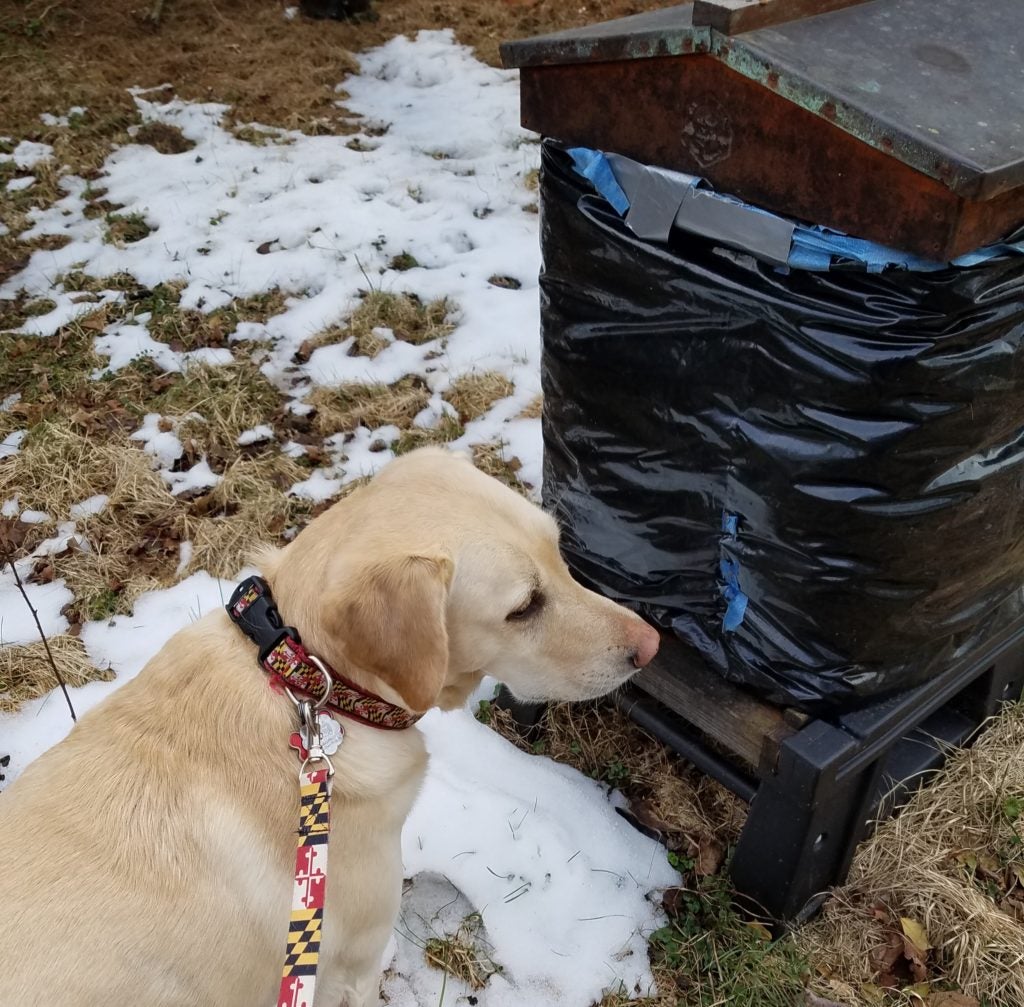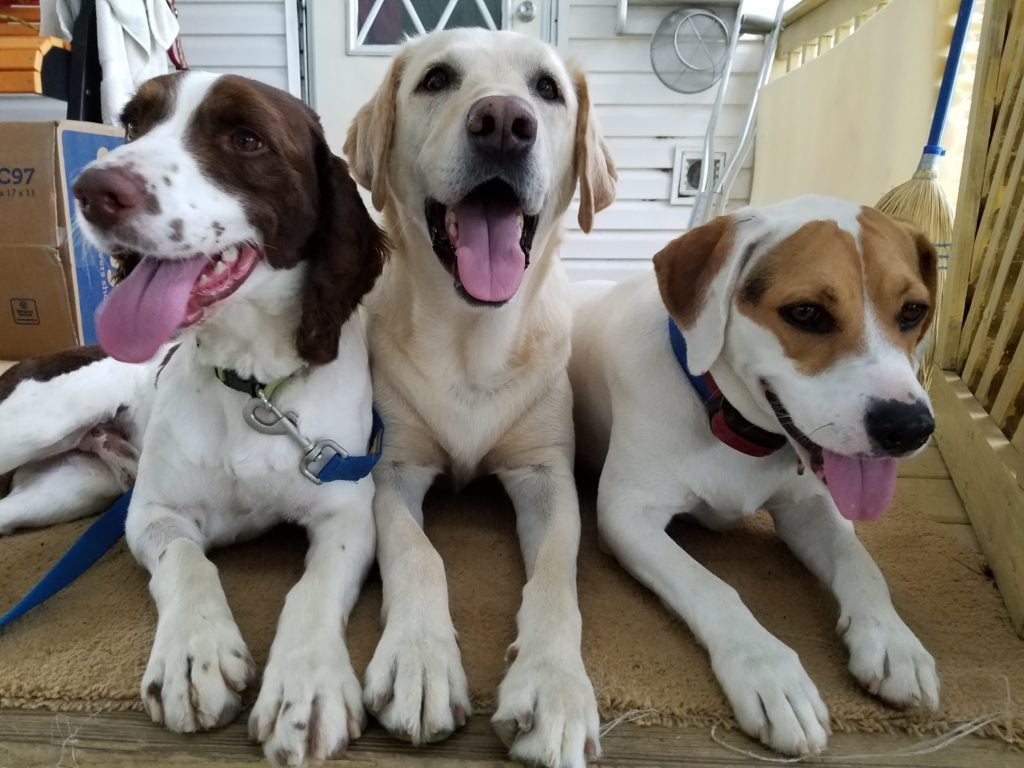
What do almonds, honeybees, and a spore-forming bacterium have in common? Mack, the bee dog. Mack is a 5-year-old Labrador Retriever tasked with protecting Maryland’s commercial honeybee populations from American Foulbrood (AFB) — one of the most devastating honeybee colony diseases.
Mack works alongside owner and handler, Cybil Preston, the chief apiary inspector for the Maryland Department of Agriculture. Preston, a master beekeeper, oversees the certification of honeybee colonies as disease-free. This is particularly important because Maryland bee colonies are often shipped across the country to pollinate food crops of almonds, citrus, and blueberries. In fact, about one-third of America’s crops require pollination, making commercial bee colonies a crucial component of agriculture.
If a colony infected with AFB was shipped to another state, it could destroy local bee populations. “One dead larva could house one million spores, making it extremely contagious,” Preston explains to AKC. Although AFB is harmless to humans, it can quickly spread from hive-to-hive and kill bees. The spores of the bacteria are present in the honey, the wax, and the wooden hive box, so when honeybees instinctively gather food and store it for the winter, the diseased hive can infect surrounding hives. “If a hive dies, other honeybees will rob the honey from the dead colony, thus removing the spores and taking them back to their colony.” That’s where Mack comes in.
Protector of Bees
Mack has been trained to detect the scent of dead bee larva. According to Preston, “Larva that die from the AFB bacteria have a specific scent.” Unlike human inspectors, who must open the colonies to examine the inside, Mack sniffs the outside of beehives and sits to alert Preston when he’s found a trace of AFB. “Mack can complete more inspections than humans, and he can also inspect colonies during cold weather, when colonies cannot be opened for human inspections,” says Preston.

Rather than working year-round, Mack works during the colder weather when the bees are dormant. This helps him avoid being stung. It also allows hive inspections to run all year. Preston explains, “We utilize him at 52 degrees and colder. Humans open hives for inspection at 60 degrees and above. So essentially, Mack works from November through March and human inspectors work March through October.”
Preston adopted Mack when the dog was younger than 2-years-old, and he has been certified as an AFB detector since he was two-and-a-half. The dog is incredibly accurate and can inspect well over 1,000 colonies a month. That makes him an amazing asset to Preston’s department. But training Mack was challenging for Preston because she had never done anything like that before. “I had never trained a dog in scent detection, but had trained my other dogs in obedience and Canine Good Citizen.”
Preston and Mack benefited from the assistance of the Maryland Department of Public Safety and Correctional Services. “They trained us on scent detection through a series of drills and games,” says Preston. Mack used special AFB toys. “We played games with toys and training aides saturated in the bacteria.” The pair started training in the spring, and they were certified by the end of the following October.
Although Mack isn’t the first bee dog employed by the Maryland Department of Agriculture, he is the only one working today. In fact, the department is the only one in the country using dogs for bee disease detection. Preston doesn’t know of any other certified bee disease detector dogs in the business.
Expanding the Team
Because Mack’s training was so successful, Preston has decided to add another dog to the detection team. She initially thought any dog could be trained for AFB detection, so she adopted a Beagle-cross named Clark. But Clark didn’t take to the job like Mack. “He is sharp and has high prey drive. But alas, he didn’t work out, as he did not like working on his own. He is a pack dog and would lose confidence and interest when working independently with me. He only liked working when he was Mack’s sidekick.”
So then Preston adopted Tukka, a springer spaniel mix. Where Mack is a laid-back people-pleaser with a high ball-drive, Tukka is a high-energy, high ball-drive firecracker. Because of that, Tukka “requires more training drills to release his intense energy,” says Preston. She hopes to have him certified by the fall. With Tukka and Mack on the job over the winter, Preston’s team will be able to work faster and protect far more honeybees.

Preston, who feels very blessed to do what she does, says her dogs thoroughly enjoy AFB detection. “I think they love training and working because they light up when I use the special words that indicate my intentions. They jump for joy when I say, ‘Let’s go,’ ‘Go get in the van,’ or ‘Let’s go work!'” And when work is over, they are both content to curl up with Preston for snuggles. “Both are lovey cuddle bugs, once they have expended their energy.”
With Mack and Tukka on the job, more and more honeybee populations are being protected from AFB. So, the next time you’re enjoying a handful of almonds or blueberries, think about the debt we owe to honeybees and the bee dogs protecting them.

